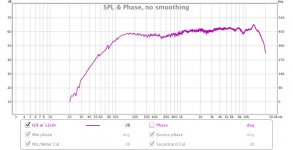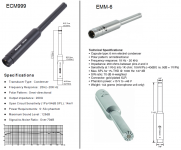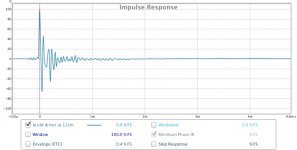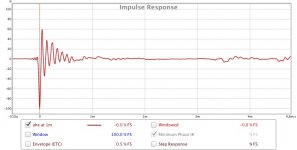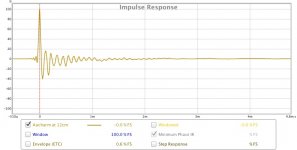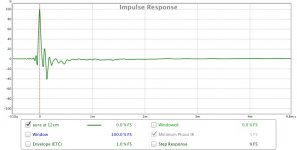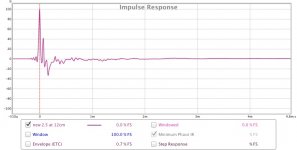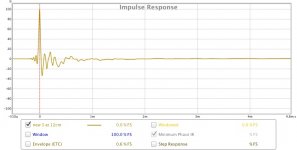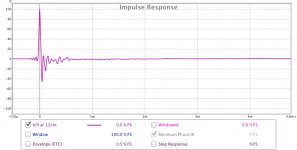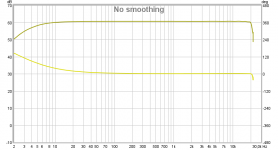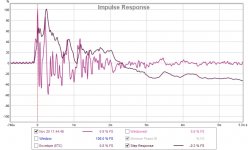Right U-DAC8 seems convenient box but in my local area cost is U-DAC8 at €325 and Essense STX II (7.1) at 250€ and STX converters on paper is higher specs. Also up till now had run USB mic UMIK-6/UMM-6 and worked fine enough but having mic single clock generated from same physical sound device opens up for REW/ARTA can go ASIO route and thereby alot more than 16bit/48kHz plus the sync that opens up for time of flight precision between driver measurements not physical placed same point in space. Think is hard to make decisions what device to buy, there always seems something that is missing comparing devices or real world performance end up not as good as paper promise. A U-DAC8 with mic input and single clock could be diy worked out combining their USBStreamer some DACs/ADC, also Overkill Audio seems release a configurable speaker toolbox next year http://www.diyaudio.com/forums/full...mr-balanced-mode-radiator-39.html#post4524514.
Will keep you posted data later next week how the PCIe soundcard platform perform local at my computers. Bus communication did impress my me today in ASIO at 4/2/1 ms settings also was stable without glitch at 176,4kHz from top JRiver DSP engine containers down stream the chain out to DACS. Also free "DPC Latency Checker v1.4.0" and "LatencyMon v5.00" showed no peak signs at those exstremes, but have to say sound stream gets a bit cold and unnatural thin at those buss speed settings and subjective a natural warm 3d flowing stream is better sensed at 10 and 20mS.
Will keep you posted data later next week how the PCIe soundcard platform perform local at my computers. Bus communication did impress my me today in ASIO at 4/2/1 ms settings also was stable without glitch at 176,4kHz from top JRiver DSP engine containers down stream the chain out to DACS. Also free "DPC Latency Checker v1.4.0" and "LatencyMon v5.00" showed no peak signs at those exstremes, but have to say sound stream gets a bit cold and unnatural thin at those buss speed settings and subjective a natural warm 3d flowing stream is better sensed at 10 and 20mS.
Last edited:
I am trying a measurement mic. I may keep it.
I got a Superlux ECM999 (it's a Taiwanese brand, so it was easy to acquire). I made a deal with the owner of the shop, who is a friend.
I bought the mic, but if I didn't like it, I could return it. Now returning merchandise is unheard of in Taiwan....
If I buy something and it falls apart in my hands, I could return it, but there will be a lot of questions and ultimately, the shop doesn't have to take it back if they don't feel like it.
Returning a product because it "didn't meet my expectations" is just impossible.
So, got the mic setup and ran sweeps with almost everything I had in the 3" category.
The TC9 looks just about right, I think, if I look at graphs online.
Do you think it's close enough?
I got a Superlux ECM999 (it's a Taiwanese brand, so it was easy to acquire). I made a deal with the owner of the shop, who is a friend.
I bought the mic, but if I didn't like it, I could return it. Now returning merchandise is unheard of in Taiwan....
If I buy something and it falls apart in my hands, I could return it, but there will be a lot of questions and ultimately, the shop doesn't have to take it back if they don't feel like it.
Returning a product because it "didn't meet my expectations" is just impossible.
So, got the mic setup and ran sweeps with almost everything I had in the 3" category.
The TC9 looks just about right, I think, if I look at graphs online.
Do you think it's close enough?
Attachments
I applaud your enthusiasm! The graphs look pretty good at first sight. Just a little question though. Did it come with any kind of calibration? A calibrated mic. would definitely have my preference. Part of the knowing what you have philosophy.
Another question that entered my mind, which IR looked cleanest of all the 3" tests you ran? This is not necessarily a serious question, but I am curious. How did the Aura wannabee do?
Another question that entered my mind, which IR looked cleanest of all the 3" tests you ran? This is not necessarily a serious question, but I am curious. How did the Aura wannabee do?
Unfortunately, no calibration. The reason I made the deal to return it if it was a little too wild. I guess it's close to the behringer ECM8000, if not the same mic.
You were right. Nothing else I have was as clean as the TC9.
I wil post about the other drivers, but it's a little late here, and I need some rest. My eyes are closing by themselves.
You were right. Nothing else I have was as clean as the TC9.
I wil post about the other drivers, but it's a little late here, and I need some rest. My eyes are closing by themselves.
And a deserved rest it is 😉. Now don't get me wrong: I will not claim that makes the TC9 the best of that bunch you tested. But I did somewhat insist you'd get your hands on it for the mere reason to have a very usable but affordable reference.
For array duties I'd definitely stick to a clean measuring driver though. You have to consider the multiply factor that is included in such a speaker. A little ringing would go a long way if you multiply it by 25 (or more). Just something to remember.
For array duties I'd definitely stick to a clean measuring driver though. You have to consider the multiply factor that is included in such a speaker. A little ringing would go a long way if you multiply it by 25 (or more). Just something to remember.
Seems weird if a product falls apart shop doesn't have to take it back, it would sound fair shop and manufacture support product liability. That said the rules here that often is a copy of rules at US market seems sometimes to free and can be misused, actually one with a low morality can buy the product and get application done then return with money back within 14 days, that seems not fair either.
Congratulation looks you got nice measurements now.
Behringer ECM8000 seems has higher output impedance but as seen below looks like ECM999 is same as EMM-6 but without a calibration file, here in EU EMM-6 is at €50 and ECM999 is at €39.
Also below a TC9 measurement with EMM-6 and supported calibration file verse your ECM999.
Congratulation looks you got nice measurements now.
Behringer ECM8000 seems has higher output impedance but as seen below looks like ECM999 is same as EMM-6 but without a calibration file, here in EU EMM-6 is at €50 and ECM999 is at €39.
Also below a TC9 measurement with EMM-6 and supported calibration file verse your ECM999.
Attachments
Last edited:
And a deserved rest it is 😉. Now don't get me wrong: I will not claim that makes the TC9 the best of that bunch you tested. But I did somewhat insist you'd get your hands on it for the mere reason to have a very usable but affordable reference.
Oh, I get that the TC9 is not the end of audio nirvana, but for the money and the performance, it's close. There's always something better, but as with everything, there's always a catch. For us, it usually is money!
The measurement looks good for the TC9. As I said before, you can use the manufacturers quoted spec for the SPL fo the TC9 and a DMM to set the absolute calibration of your mic. Set REW to generator mode to make sine wave at 1khz and adjust amplitude until 2.83v (AC volts) at driver. Put mic 1.0 meter away and then use the "SPL meter" function in REW, there is a "calibrate" button. Click that and then type in 84.6dB (from spec sheet for 2.83v).
Btw, I just noticed that the TC9 has a new April 2015 spec sheet out now. I wonder if anything has changed?
http://www.parts-express.com/pedocs/specs/264-1062--tymphany-tc9fd18-08-spec-sheet.pdf
Then to make sure the number makes sense, adjust the volume until music sounds loud enough to be a dance club level where its hard to hear yourself talk. that is about 89dB.
Your mic won't be calibrated for SPL variation along frequency, but based on your measurement, it looks pretty good (flat). Good enough to design speakers with within +/-1.5dB I would guess.
Btw, I just noticed that the TC9 has a new April 2015 spec sheet out now. I wonder if anything has changed?
http://www.parts-express.com/pedocs/specs/264-1062--tymphany-tc9fd18-08-spec-sheet.pdf
Then to make sure the number makes sense, adjust the volume until music sounds loud enough to be a dance club level where its hard to hear yourself talk. that is about 89dB.
Your mic won't be calibrated for SPL variation along frequency, but based on your measurement, it looks pretty good (flat). Good enough to design speakers with within +/-1.5dB I would guess.
They don't want to deal with returns because that's a lot of paperwork here, plus they get their refund from the manufacture or distributor months later. Another example, I couldn't return a bottle of wine that was really bad, turned to awful vinegar. I had to call the distributor directly, and they told the store to take the bottle back. The owner was so pissed... of course, that meant I wouldn't be able to buy wine from that store ever again! 😉
It's true that many people around here used the return policy from many other stores with little scruples. I've seen girls buy expensive dresses for a party, then return the clothes after the party to get their money back. It was getting really out of hands that the stores decided on a rule of no returns unless you can prove the item was broken when you opened the box.
Problem is that you can't open the box before buying it here, as people here need to see that the product is completely new, so the packaging needs to the perfect.
So guess what, no demo anywhere! Just the picture on the box!
It's true that many people around here used the return policy from many other stores with little scruples. I've seen girls buy expensive dresses for a party, then return the clothes after the party to get their money back. It was getting really out of hands that the stores decided on a rule of no returns unless you can prove the item was broken when you opened the box.
Problem is that you can't open the box before buying it here, as people here need to see that the product is completely new, so the packaging needs to the perfect.
So guess what, no demo anywhere! Just the picture on the box!
Thanks guys, I guess that mic is a keeper than.
Good thing!
So...
Here's a bunch of impulses from the drivers I have lying around.
They are from the TC9, a new 3", a new 2.5", the Aura, the awful Aucharm, the AHE and the little 3" I used in my old Line Arrays.
PS. Sorry, the AHE has an inverted impulse as I forgot my little 3116 amp has inverted +/- outputs!
Good thing!
So...
Here's a bunch of impulses from the drivers I have lying around.
They are from the TC9, a new 3", a new 2.5", the Aura, the awful Aucharm, the AHE and the little 3" I used in my old Line Arrays.
PS. Sorry, the AHE has an inverted impulse as I forgot my little 3116 amp has inverted +/- outputs!
Attachments
Thanks IR plots, the last three look advanced having kind of room reflection build in to output waveform : )
New mic did made big difference, looks like at TC9 FR plot start/end frq sweep is set to 20-20kHz if possible will like to see it from DC to 22,05 or 24kHz, also is soundcard I/O response calibrated inside REW before taking those measurements because if not ringing scheme should improve when compensated pointing to a calibration file actual sample rate mode.
New mic did made big difference, looks like at TC9 FR plot start/end frq sweep is set to 20-20kHz if possible will like to see it from DC to 22,05 or 24kHz, also is soundcard I/O response calibrated inside REW before taking those measurements because if not ringing scheme should improve when compensated pointing to a calibration file actual sample rate mode.
Ok, I'll go up to 24kHz next time.
I didn't apply a soundcard calibration in REW. I'll have to read about that.
I didn't apply a soundcard calibration in REW. I'll have to read about that.
One is guided with help and explanation at bottom in window, just go to "Preferences" then "Soundcard" tab, then "Calibrate" and guide starts at bottom in window. Do it for every sample rate and save file with a logic name example "Presonus_WDM_48kHz" so its easy to be recalled or imported to another computer if it's a remove able sound card. Before taking a measurement check current active calibration file is the one belonging to actual soundcard hardware and actual sample rate.
Last edited:
Nice measurements Perceval - the mic looks like a winner. I think the sound card calibration is as simple as connecting a loopback and clicking "calibrate" sound card under settings. What did your mic cost in USD? If you get a chance, order the UMIK-1 and a miniDSP - you will find a billion uses for the miniDSP - it is a game changer and let me get into 2-ways, 3-ways, and FAST without knowing how to build a passive XO.
Example UCA222 loopback WDM 16bit/44,1kHz.
Picture 1 soundcard I/O wire loopback with no calibration showing soundcard real response.
Picture 2 soundcard I/O wire loopback with calibration file loaded which corrects for system non linearity so system now truly a reference measurement system and ready to put in a DUT. (In both plots "Estimate IR Delay" button had been pushed to correct phase)
Picture 1 soundcard I/O wire loopback with no calibration showing soundcard real response.
Picture 2 soundcard I/O wire loopback with calibration file loaded which corrects for system non linearity so system now truly a reference measurement system and ready to put in a DUT. (In both plots "Estimate IR Delay" button had been pushed to correct phase)
Attachments
Ok, I may have some quiet time tomorrow. I'll try to apply it.
X, I know a MiniDSP would be fun, but I already do something similar using JRiver and my 8-output sound card. Not completely the same of course, but I can still do some DSP magic between channels.
X, I know a MiniDSP would be fun, but I already do something similar using JRiver and my 8-output sound card. Not completely the same of course, but I can still do some DSP magic between channels.
Just saying if you decide to buy a calibrated UMIK-1 to just add the miniDSP as well. It has the advantage of being able to operate computer less once settings are uploaded. Not having to be tied to a computer and sound card are handy features.
I'm running into a catch-22 right now.
I have started to do the sound card calibration.
I couldn't make it work under Java, but switching to Asio in the REW preferences worked ok. Using Asio, I can only select one speaker at a time, either the right or the left, but not in stereo.
So, I made cal files for 44.1, 48 and 96kHz.
Looked as it should be.
Now trying to select JRiver as the output in Asio mode crashes REW every time. I tried with or without the cal file, I tried all 3 freq settings, it always crashes.
I then switched back to Java, but I run into the sweeps going wild after the first one. Also, the impulse is so erratic, I do not trust that Java sweep at all. Something is definitively not right.
I have started to do the sound card calibration.
I couldn't make it work under Java, but switching to Asio in the REW preferences worked ok. Using Asio, I can only select one speaker at a time, either the right or the left, but not in stereo.
So, I made cal files for 44.1, 48 and 96kHz.
Looked as it should be.
Now trying to select JRiver as the output in Asio mode crashes REW every time. I tried with or without the cal file, I tried all 3 freq settings, it always crashes.
I then switched back to Java, but I run into the sweeps going wild after the first one. Also, the impulse is so erratic, I do not trust that Java sweep at all. Something is definitively not right.
Attachments
I never deal with Java or ASIO mode when using a USB mic - with UMIK-1 it truly is plug and play. Is this because you have a sound card internally? I remember trying to use my Zoom recorder in Holmimpulse once and it used ASIO. The sweep had all sorts of latency issues over USB with ASIO.
- Status
- Not open for further replies.
- Home
- Loudspeakers
- Full Range
- Aura wannabe... maybe
